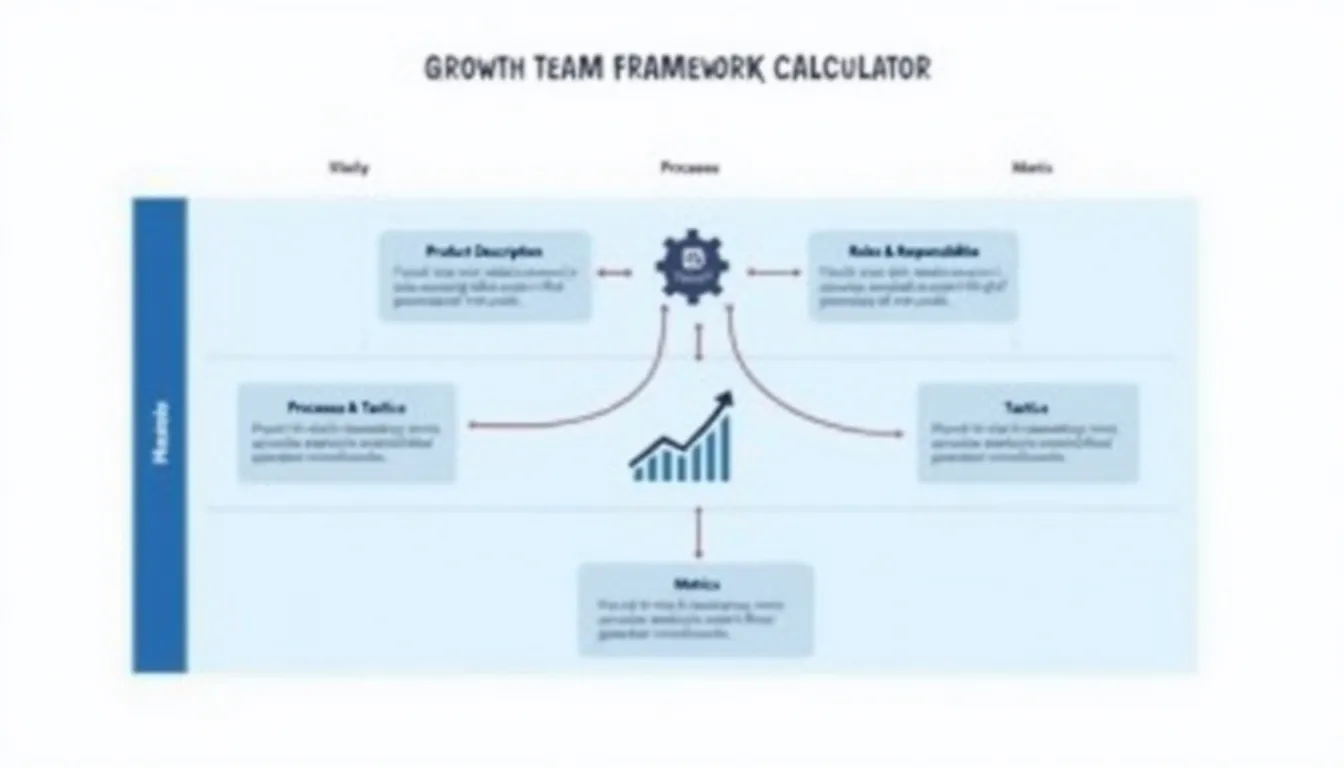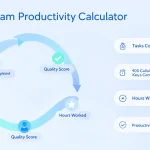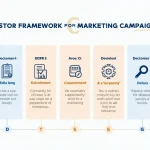Is this tool helpful?
How to Use the Growth Team Framework Calculator Effectively
The Growth Team Framework Calculator is a powerful tool designed to help you create a comprehensive marketing campaign outline using the Growth Team Framework. This calculator assists in building a cross-functional team with the skills and expertise needed to drive growth for your product or service. Here’s how to use it effectively:
1. Description of the Product or Service
In the first field, provide a detailed description of your product or service. This information is crucial for tailoring the growth strategy to your specific offering. For example:
- “Our product is a mobile app that helps users track their daily water intake and provides personalized hydration recommendations based on their activity level, climate, and health goals.”
- “We offer a subscription-based meal planning service that creates customized weekly menus and grocery lists based on dietary preferences, allergies, and nutritional goals.”
2. Roles and Responsibilities
In the second field, outline the roles and responsibilities within your growth team. This helps in establishing clear expectations and accountability. For instance:
- “Growth Lead: Oversees the entire growth strategy and coordinates team efforts.”
- “Data Analyst: Responsible for tracking and interpreting key metrics.”
- “Content Marketer: Creates and distributes engaging content across various channels.”
- “Product Manager: Ensures product features align with growth objectives.”
3. Processes to Support the Cross-Functional Team
In the third field, detail the processes that will support your cross-functional team. These processes ensure smooth collaboration and efficient execution of growth strategies. For example:
- “Weekly growth meetings to review progress and align on priorities.”
- “Monthly retrospectives to identify areas of improvement in team processes.”
- “Quarterly strategy sessions to reassess and adjust growth objectives.”
4. Specific Tactics to Drive Growth
In the fourth field, list specific tactics you plan to use to drive growth. These tactics should be tailored to your product or service and target audience. For instance:
- “Implement a referral program offering discounts for both the referrer and new customer.”
- “Launch a series of educational webinars to showcase product features and benefits.”
- “Develop partnerships with complementary businesses for co-marketing opportunities.”
5. Metrics to Measure Effectiveness
In the final field, specify the metrics you’ll use to measure the effectiveness of your growth strategy. These metrics should align with your overall business objectives. For example:
- “Customer Acquisition Cost (CAC)”
- “Monthly Recurring Revenue (MRR) growth rate”
- “User retention rate at 30, 60, and 90 days”
- “Net Promoter Score (NPS)”
After filling in all the fields, click the “Submit” button to generate your customized Growth Team Framework outline. The calculator will process your inputs and provide a comprehensive strategy tailored to your specific needs.
Understanding the Growth Team Framework Calculator
The Growth Team Framework Calculator is an innovative tool designed to streamline the process of creating a robust growth strategy for businesses of all sizes. By leveraging the principles of the Growth Team Framework, this calculator helps organizations build and manage cross-functional teams dedicated to driving sustainable growth.
What is the Growth Team Framework?
The Growth Team Framework is a systematic approach to building and managing cross-functional teams focused on driving business growth. It emphasizes the importance of aligning various departments and skill sets to create a cohesive growth strategy. This framework typically includes elements such as:
- Team structure and composition
- Clear roles and responsibilities
- Defined processes and workflows
- Growth tactics and experiments
- Key performance indicators (KPIs) and metrics
Purpose of the Calculator
The primary purpose of this calculator is to simplify the process of implementing the Growth Team Framework within your organization. It helps you:
- Define your product or service clearly
- Establish roles and responsibilities within your growth team
- Develop supporting processes for team collaboration
- Identify specific growth tactics
- Select appropriate metrics to measure success
By inputting information about your business and growth objectives, you receive a tailored outline that serves as a starting point for your growth strategy.
Benefits of Using the Growth Team Framework Calculator
1. Time Efficiency
Creating a comprehensive growth strategy from scratch can be time-consuming. This calculator significantly reduces the time required to develop a solid foundation for your growth team and strategy. By providing a structured framework and prompting you for specific information, it streamlines the planning process, allowing you to focus more on execution.
2. Customization
While the Growth Team Framework provides a general structure, every business has unique needs and challenges. This calculator takes into account your specific product or service, team composition, and growth objectives to create a tailored strategy. This level of customization ensures that the resulting plan is directly applicable to your business context.
3. Cross-Functional Alignment
One of the key principles of the Growth Team Framework is the alignment of different departments and skill sets. By prompting you to define roles, responsibilities, and processes, the calculator helps ensure that your growth strategy incorporates diverse perspectives and leverages the full range of talents within your organization.
4. Strategic Focus
The calculator guides you through the process of identifying specific growth tactics and metrics. This helps maintain a strategic focus on activities that directly contribute to growth, rather than getting sidetracked by less impactful initiatives. By clearly defining your tactics and metrics upfront, you set the stage for more effective execution and measurement of your growth efforts.
5. Scalability
Whether you’re a startup looking to achieve product-market fit or an established company aiming for expansion, the Growth Team Framework Calculator can adapt to your needs. It provides a scalable approach to growth that can evolve as your business grows and your objectives change.
6. Data-Driven Decision Making
By emphasizing the importance of selecting appropriate metrics, the calculator encourages a data-driven approach to growth. This focus on measurable outcomes helps teams make more informed decisions and continuously improve their growth strategies based on real-world results.
Addressing User Needs and Solving Specific Problems
The Growth Team Framework Calculator addresses several common challenges faced by businesses looking to implement a structured approach to growth:
1. Lack of Clear Strategy
Many businesses struggle to develop a coherent growth strategy that aligns all aspects of their operations. The calculator solves this by providing a structured framework that covers all essential elements of a growth strategy, from team composition to specific tactics and metrics.
2. Siloed Departments
Traditional organizational structures often lead to departments working in isolation, hindering overall growth efforts. The Growth Team Framework Calculator emphasizes cross-functional collaboration, helping break down these silos and fostering a more integrated approach to growth.
3. Ineffective Resource Allocation
Without a clear strategy, businesses may waste resources on ineffective growth initiatives. By guiding users to define specific tactics and metrics, the calculator helps ensure that resources are allocated to activities with the highest potential impact on growth.
4. Difficulty in Measuring Success
Many organizations struggle to effectively measure the success of their growth efforts. The calculator addresses this by prompting users to select appropriate metrics, ensuring that growth initiatives are tied to measurable outcomes.
5. Lack of Accountability
When roles and responsibilities are unclear, it can lead to a lack of accountability within growth teams. The calculator solves this by encouraging users to clearly define roles and responsibilities, fostering a culture of ownership and accountability.
Practical Applications and Use Cases
The Growth Team Framework Calculator can be applied in various business scenarios. Here are some practical examples:
1. SaaS Startup Scaling User Acquisition
A software-as-a-service (SaaS) startup might use the calculator to develop a growth strategy focused on user acquisition. Their inputs might look like this:
- Product Description: “Cloud-based project management software for remote teams”
- Roles: Growth Lead, Product Manager, Content Marketer, Paid Acquisition Specialist
- Processes: Weekly growth meetings, bi-weekly A/B test reviews
- Tactics: Content marketing, referral program, targeted paid advertising
- Metrics: Customer Acquisition Cost, Trial-to-Paid Conversion Rate, Monthly Recurring Revenue Growth
The resulting strategy would provide a roadmap for the startup to systematically grow its user base while keeping acquisition costs in check.
2. E-commerce Business Expanding to New Markets
An established e-commerce business looking to expand into new geographic markets could use the calculator as follows:
- Product Description: “Online marketplace for handmade artisanal products”
- Roles: Market Expansion Lead, Localization Specialist, Supply Chain Manager, Digital Marketing Manager
- Processes: Monthly market performance reviews, quarterly strategy adjustments
- Tactics: Localized SEO, partnerships with local influencers, targeted social media campaigns
- Metrics: New Market Revenue Growth, Customer Lifetime Value by Region, Market Share
This would result in a tailored strategy for entering and growing in new markets while leveraging the company’s existing strengths.
3. Mobile App Improving User Retention
A mobile app struggling with user retention could use the calculator to develop a growth strategy focused on engagement and retention:
- Product Description: “Fitness tracking app with personalized workout plans”
- Roles: Product Manager, UX Designer, Data Analyst, Customer Success Manager
- Processes: Weekly user feedback reviews, monthly feature prioritization meetings
- Tactics: Personalized push notifications, gamification of workout streaks, community challenges
- Metrics: 30-day retention rate, Daily Active Users, Feature adoption rates
The resulting strategy would provide a framework for systematically improving user engagement and retention through product improvements and targeted communication.
Frequently Asked Questions (FAQ)
Q1: Who should use the Growth Team Framework Calculator?
A1: This calculator is beneficial for businesses of all sizes and industries looking to implement a structured approach to growth. It’s particularly useful for startups, scale-ups, and established companies undergoing digital transformation or entering new markets.
Q2: How often should I use the calculator?
A2: It’s recommended to use the calculator when first establishing your growth team and strategy, and then revisit it quarterly or bi-annually to refine your approach based on results and changing business objectives.
Q3: Can I use the calculator if I don’t have a dedicated growth team yet?
A3: Absolutely! The calculator can help you define the roles and responsibilities you need in a growth team, which can guide your hiring or role assignment decisions.
Q4: How detailed should my product/service description be?
A4: Provide enough detail to capture the unique value proposition of your product or service. Include information about your target audience, key features, and how it solves customer problems.
Q5: What if I’m not sure about the best growth tactics for my business?
A5: Start with tactics that align with your business model and target audience. The calculator’s output can serve as a starting point, which you can refine based on experimentation and results.
Q6: How many metrics should I track?
A6: While it’s tempting to track many metrics, focus on 3-5 key metrics that directly align with your growth objectives. This ensures focus and prevents data overload.
Q7: Can the Growth Team Framework be applied to non-profit organizations?
A7: Yes, the framework can be adapted for non-profits. Instead of focusing on revenue growth, you might focus on metrics like donor acquisition, volunteer engagement, or impact measurements.
Q8: How does the Growth Team Framework differ from traditional marketing approaches?
A8: The Growth Team Framework emphasizes cross-functional collaboration, rapid experimentation, and data-driven decision making. It integrates product development, marketing, and customer success efforts more closely than traditional approaches.
Q9: Can I share the calculator’s output with my team?
A9: Yes, the output is designed to be shared. Use it as a starting point for team discussions and strategy refinement.
Q10: How can I ensure buy-in from different departments for the growth strategy?
A10: Involve representatives from different departments in the process of using the calculator. This collaborative approach helps ensure that the resulting strategy considers diverse perspectives and fosters buy-in across the organization.
By leveraging the Growth Team Framework Calculator, businesses can develop comprehensive, tailored growth strategies that align teams, focus efforts on high-impact activities, and drive measurable results. Whether you’re a startup looking to scale rapidly or an established company seeking to reinvigorate growth, this tool provides a structured approach to achieving your business objectives.
Important Disclaimer
The calculations, results, and content provided by our tools are not guaranteed to be accurate, complete, or reliable. Users are responsible for verifying and interpreting the results. Our content and tools may contain errors, biases, or inconsistencies. We reserve the right to save inputs and outputs from our tools for the purposes of error debugging, bias identification, and performance improvement. External companies providing AI models used in our tools may also save and process data in accordance with their own policies. By using our tools, you consent to this data collection and processing. We reserve the right to limit the usage of our tools based on current usability factors. By using our tools, you acknowledge that you have read, understood, and agreed to this disclaimer. You accept the inherent risks and limitations associated with the use of our tools and services.







